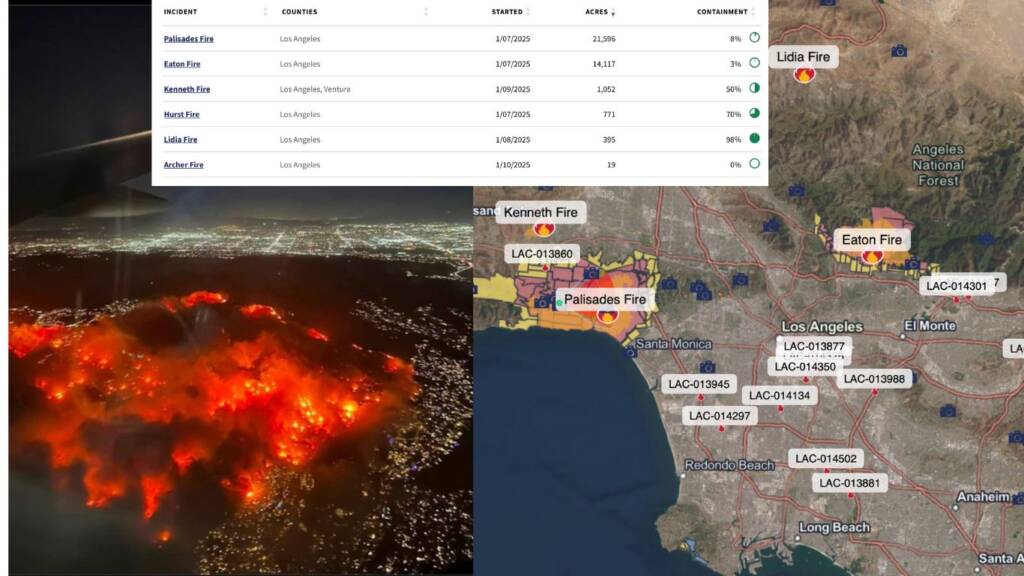California is currently confronting a terrible series of wildfires that have surged through Los Angeles County. The fire has killed at least 16 people, displacing hundreds and destroying homes, businesses, and natural habitats. With severe effects on people, the economy, and the environment, these fires—which are caused by harsh weather and climate conditions—represent one of the biggest disasters in the state’s history.
According to California fire officials, there are at more than five fires raging in the wider area.
The first fire to erupt on Tuesday, and the largest in the Palisades region, has the potential to become the most catastrophic fire in state history. It has scorched a large area of land, more than 21,000 acres, including the upscale Pacific Palisades neighbourhood. It was 8 per cent contained as of Saturday morning. The fire has alao spread to other regions like Eaton, Hurst, Lidia, Archer and Kenneth among others
According to reports a suspect had been detained near the Kenneth Fire site on unrelated charges, but no direct evidence has linked them to starting the fires.
The earlier Sunset, Woodley and Olivas fires have been contained.
According to media reports, overall, more than 10,000 buildings have been destroyed, with another 60,000 at risk.Insured losses are estimated to exceed $8 billion, given the high value of properties in the affected areas. Additionally, around 153,000 people are under evacuation orders, with another 166,000 under warnings to prepare for potential evacuation.
Immediate Triggers
Understanding the nature of devastation and investigating the immediate and long-term triggers becomes imperative. While investigations are still ongoing, experts have cited some factors that may have caused the fire.
Utility Equipment: Fires such as the Eaton and Hurst fires began near high-voltage transmission lines operated by Southern California Edison (SCE). The Palisades fire also erupted near underground power lines maintained by the Los Angeles Department of Water and Power (DWP). These incidents highlight the potential role of electrical infrastructure failures.
Environmental Conditions: California’s climate has made the state perfect for wildfires. The strong Santa Ana winds and excess heat caused triggered the fire and spread quickly over the area.
Long-Term Drivers
Climate change has significantly amplified the risk and severity of wildfires in California. Experts attribute this to a phenomenon known as “weather whiplash,” characterized by alternating cycles of extreme wet and dry conditions. Last winter’s torrential rains spurred lush vegetation growth, which has since dried into highly flammable tinder under the heat of a record-breaking summer.
Daniel Swain, a climate scientist at UCLA, explained that this cycle has “doubled the fire risk,” first by increasing vegetation growth and then drying it out to unprecedented levels. The National Oceanic and Atmospheric Administration (NOAA) has also highlighted how increased heat, extended droughts, and a “thirsty atmosphere” have heightened wildfire risks across the western United States.
Challenges in Controlling the Fires
Governments and local authorities are trying to contain the fires but face tremendous obstacles. Those obstacles are as follows:
Severe Weather: The Santa Ana winds have spread the flames as well as affected aerial firefighting efforts. Humidity levels have decreased dramatically, which dries the vegetation and fuels the wildfires.
Strained Water Systems: Firefighters in regions like Pacific Palisades and Altadena encountered empty hydrants and low water pressure. Power outages disrupted pumps essential for maintaining water flow. In high-elevation neighbourhoods, gravity-fed storage tanks were quickly drained, and maintenance outages in nearby reservoirs compounded the problem.
The Steps Being Taken
Authorities are taking both immediate and long-term measures to address the crisis in order to mitigate the fire but have not yet succeeded.
Firefighting Efforts: More than ten thousand firefighters are fighting the fire. Aerial units and National Guard troops support these firefighters. However, the fires are expected to continue burning until weather conditions improve or they run out of fuel.
Upgrading Infrastructure is the need of the hour. Measures, such as the expansion of water storage capacity, modernization of pipelines, and the development of backup power systems, maybe a reliable service during this natural disaster.
Evacuation and Relief: Tens of thousands of residents have been evacuated, with shelters set up to provide temporary housing. National Guard troops have been deployed to prevent looting in evacuated areas, and local authorities are investigating reports of scams targeting fire victims.
Governor Newsom said there is a need for immediate investments in climate resilience and infrastructure upgrades. “There’s no fire season anymore,” he said. “It’s year-round in the state of California.”
Future Outlook
No significant rain is expected during the coming week, so the conditions remain conducive to further wildfires. Winds will ease a bit but then strengthen again over the weekend, creating a continued threat. Some fires, such as Lidia and Hurst, are near containment, but the Palisades and Eaton fires remain largely uncontained, making the situation very challenging.
Although California had more fires than normal this year, overall land burned is somewhat lower than the five-year average but greater than last year. Forecasts show that above-normal temperatures and below-normal precipitation will continue through February, posing an enhanced fire risk, particularly in Southern California. The increased frequency of offshore wind events may also raise fire hazards in certain places.
Over the next few months, an active Jet Stream is expected to produce cold, moist conditions that will promote the growth of lowland flora and snow in higher elevations. These conditions, combined with a shift toward greener fuels, are projected to reduce the risk of major fires during the next 2-3 months. Southern California is the exception, with some increased fire risk expected to persist.
